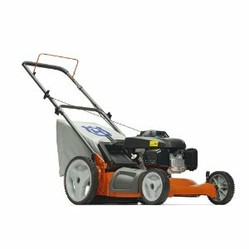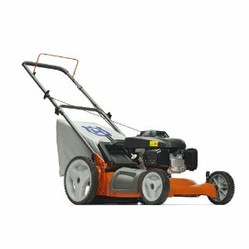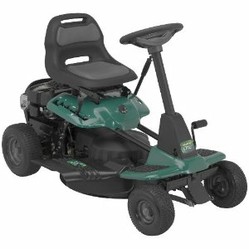Is the mower out of gas?
Did you hit, or run over something with the mower in the grass?
Oh yeah, people do run out of gas, put their mower away in the garage or garden shed with an empty fuel tank and forget about it until next time. Only to pull on the starter rope until they either break the recoil starter rope, or further frustrate and exhaust themselves. Do yourself a favor, check the fuel tank and make sure it is not empty.
 Hitting something in the grass will cause mechanical problems in a lawn mower engine. Something as seemingly harmless as hitting a baseball in the grass, exposed tree root or some other foreign object will do several bad things that will in turn. Kill the engine straight away or keep it from starting after shutting the mower off, damage the blade, bend the crankshaft or shear the flywheel-key all of which are expensive to have repaired at a mower repair shop. Many repair shops will tell you, buying a new mower is a better investment.
Hitting something in the grass will cause mechanical problems in a lawn mower engine. Something as seemingly harmless as hitting a baseball in the grass, exposed tree root or some other foreign object will do several bad things that will in turn. Kill the engine straight away or keep it from starting after shutting the mower off, damage the blade, bend the crankshaft or shear the flywheel-key all of which are expensive to have repaired at a mower repair shop. Many repair shops will tell you, buying a new mower is a better investment.
The most common thing that happens in cases like these, when the mower blade hits a small foreign object or tree root the flywheel key, by the way an inexpensive part, gets either partially or completely sheared. Throwing the engine ignition out of time the mower may stop running, backfire, run poorly or not start after shutting the engine off.
Tip, when the starter rope handle jerks back, the engine is most likely, either out of time, or the engine cylinder is flooded with raw gas or oil from the crankcase, remove the spark plug and pull the rope to clear the gas and oil from the cylinder.
 The fix, First remove the spark plug from the engine, with the plug removed, place the mower on its side with the carburetor / air-cleaner cover up. Then check the mower blade for damages, is it bent, chipped or has gouges in the cutting edges.
The fix, First remove the spark plug from the engine, with the plug removed, place the mower on its side with the carburetor / air-cleaner cover up. Then check the mower blade for damages, is it bent, chipped or has gouges in the cutting edges.
Rotate the mower blade in a clockwise rotation, while watching the engine crankshaft. You are looking to see if the crankshaft wobbles side to side while it spins. This is to ensure the crankshaft is not bent. When it wobbles from side to side the shaft is bent, and it is time you buy a new mower.
Otherwise, replace the damaged flywheel key and you will be back in business. With the mower back on its wheels, it is time to fix the damaged flywheel key. Remove the blower-housing, top covering the flywheel. Pull the flywheel off the top of the crankshaft and replace the sheared flywheel key. Sounds easy right, it really is but here again. Each engine has its own specific steps where a good Haynes small engine repair manual helps guide you through the simple step-by-step procedures.


 The first thing we need to understand, there are three critical things a 4-cycle gas-powered lawn mower engine must have happening at the right time, and in the proper amounts, before a OHV gas engine will start and run without fail. Good clean, fresh fuel, good compression, and the ignition-providing spark across the gap of the spark plug make-up the critical components internal combustion engine must have before it will ever start and run properly.
The first thing we need to understand, there are three critical things a 4-cycle gas-powered lawn mower engine must have happening at the right time, and in the proper amounts, before a OHV gas engine will start and run without fail. Good clean, fresh fuel, good compression, and the ignition-providing spark across the gap of the spark plug make-up the critical components internal combustion engine must have before it will ever start and run properly.





















 Apple Watch the Best Talking Watch Bargainon 01/16/2023
Apple Watch the Best Talking Watch Bargainon 01/16/2023
 In-depth review of a Bushcraft Backpacking Survival hatcheton 12/05/2014
In-depth review of a Bushcraft Backpacking Survival hatcheton 12/05/2014
 Winterizing windows – Easy and inexpensive DIY projecton 11/17/2014
Winterizing windows – Easy and inexpensive DIY projecton 11/17/2014
 Growing cucumbers on a trellis is fun and easyon 08/05/2014
Growing cucumbers on a trellis is fun and easyon 08/05/2014



Comments
Happy to help Katie, let's all work to keep the planet green!
This is amazing. WOW I see so many lawnmowers out on the sidewalk on trash day. I just know, after reading this, they could have been saved, running mowers you could sell for profit. What a great idea for a young person to earn money and take care of the planet. I know my lawn mower will be in the family a long long time now that I have your handy amazing guide to repair. How to repair a lawn mower is priceless information and something I never thought of before. Thanks for saving the planet one mower at a time, now there won't be so many going into our landfills that should still be mowing. Katie